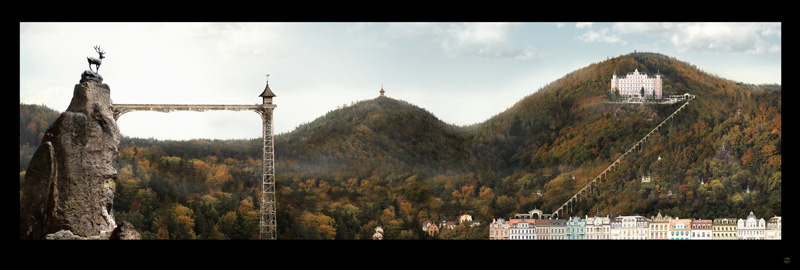Ulrich Zeidler is an incredibly successful storyboard and concept artist who has over 20 years of experience in the business. He’s a member of the British Production Designers Guild, and his images and creative designs have helped create iconic environments in such well-known projects as “Shang-Chi,” “The Grand Budapest Hotel,” “Ready Player One,” and the last season of “Game of Thrones”. But a quick search on his IMDB page will show you he’s done, and continues to do, much much more. I was lucky enough to speak with Ulrich on what made him get into concept art, what it was like working on some of these iconic projects, and any advice he has for other artistically inclined people who may want to pursue concept art as a career.
I was a little anxious to be speaking with someone so accomplished, but as soon as he started talking, all my worries slipped away. Ulrich carries himself with an air of professionalism, there’s weight in every tale he tells. After all, this is someone who’s done the difficult task of becoming successful in a creative field, and yet he manages to come across as quite approachable. Before I knew it, it felt like I was talking to an old friend. Our conversation was spectacular, and I was extremely gracious for the information and advice Ulrich was willing to share. The first thing I wanted to nail down was how exactly his career in concept art began.
Ulrich’s trajectory was an interesting one. Growing up he loved to draw, but while his dad would encourage him to try and replicate the things he saw in real life, Ulrich loved illustrating imaginary monsters, fantasy creatures, or things from books that didn’t exist. His love of fiction continued into his teenage years, “I got this art of ‘Star Wars’ book. The little blue one with the designs for ‘The Empire Strikes Back’. [And] I started reverse engineering their techniques, which wasn’t easy.” However, when he was ready to go to college things took a turn. Unlike most concept artists who, “at some point, want to go to art school,” and will pursue concept art from there, Ulrich went to med school. Not only did he attend, but he studied for years and eventually graduated with his doctorate. After all that work, Ulrich came to the realization that a future in medicine just wasn’t for him.

“If someone is artistically inclined then the prospect of not being able to do anything creative for the next 40 years and not even being able to sleep in your own bed more than every other weekend isn’t very appealing. And if you don’t even make decent money for it then no, thank you. That’s not what I want.”
Ulrich decided to take the massive leap and start looking for jobs in concept art. So, what exactly is concept art? A literal definition is a form of visual art used to convey an idea for use in films, video games, animation, and other forms of media before it is put into the final product. Or as Ulrich put it simply, “I design stuff.” Ulrich works in the art department, under the Production Designer, “the Production Designer is on the same tier as a Director and the Director of Photography,” he tells me. They have access to the script right away and are in charge of designing what the literal environments will look like based on what’s written in the text.
“If the Production Designer doesn’t have time to do the designs himself, he needs a bunch of people who actually do the designs. The Production Designer would then art direct. So, he has his vision and I get asked to come up with ideas for something.”
When Ulrich worked on “Ready Player One” he was lucky enough to be the first person hired onto the team. As he explained to me, this allowed him free-range to have his try at designing whatever he wanted, “in Ready Player One there’s hardly anything that I haven’t touched at some point but on things like “Shang-Chi” from the beginning I was tasked with developing the secret hidden village. So I worked on the secret hidden village for many, many weeks.” It just depends on the luck of the draw. The biggest goal in concept art is that every design supports the narrative that’s being conveyed. As a concept artist, you’re working with a client, and trying to make their vision come true. In some cases, this allows for more creativity than others. While Marvel films are an honor to work on, Ulrich explained there’s not a lot of room to be experimental. You can’t deviate from the comics. For the most part, your design has to be nearly exact to what audiences have already seen.

Concept artists almost always have access to the script of the project they’re working on, “I personally feel it’s necessary for me to know the entire script because I’m actually taking the subtext and making it into something tangible,” Ulrich says. But some productions are more intense with security than others. Ulrich shared with me that when he worked on the last season of “Game of Thrones” they were, understandably, a little protective of their scripts. Approval for any episode’s script could take as long as a few days, which led to the Production Designer just taking photos of the script on her iPad to show him. As there were things she needed him to do that couldn’t wait.
So, how does one become a concept artist? “Well, first of all, you have to be an artist,” Ulrich states. Though he takes this back with comical speed as he’s reminded of Anthony Jones, an artist who’s worked with Blizzard Entertainment, SCEA, Hasbro, and Robox, and had a pretty unconventional entrance into the art world. Anthony did not draw as a child and became a plumber once he grew up. He realized he didn’t like plumbing and wanted to go into the gaming industry. After looking into what would get him in the industry the fastest, Anthony decided to become an artist. He gave himself the goal that in a few years he would be an amazing artist, and he was.
“But that’s the only such example. Most people have always been artistically inclined and have been drawing in kindergarten and all through high school. Then at some point, they want to go to art school and then they want to go into concept art. So that would be the normal thing.”
Ulrich got his start in advertising, where he was able to find instant success, “In Germany, in advertising, you can make five times as much money as in movies. In advertising, you can easily get paid $1000 a day. So even if it’s painful, a few days makes you enough money to live off for a month.” The only downside was that Ulrich hated the environment. It wasn’t as fulfilling as he had hoped, and the people he ended up working with weren’t as kind as the creatives he’d eventually find his way to in the film industry. But, it gave him a start. As Ulrich did advertising, he reached out to people in the industry on the side. First, he tackled being involved with films locally, then, as he gained more experience and broadened his portfolio, he tried internationally. While now his resume reads like a listing of Hollywood’s biggest blockbuster hits, he wants people coming into the industry to manage their expectations, “It usually takes a person a minimum of 10 – 15 years to make it to the kind of productions that we’ve been speaking about so far,” with him pointing out he could have gotten there earlier had med school not delayed him from pursuing concept art till 1998.
I asked Ulrich if there are any art schools or programs he recommends applying to. He mentioned, “Art Center College of Design in Pasadena now has a program that’s called Entertainment Design. So you can actually go to school for being a concept artist.” But, there’s a caveat, “The bad thing about this is that Art Center now turns out 150 concept artists per year every year.” Meaning the field might be oversaturated. Ulrich points out this is a big turnaround from when George Lucas was pitching the original “Star Wars” trilogy in 1975. Concept art wasn’t really a thing and he had to find someone who wasn’t even an artist, Ralph McQuarrie, but had high enough credentials to create the type of designs Lucas needed. More people being concept artists doesn’t mean there isn’t demand, but it may not be in film, “Most concept artists will probably work in the games industry, but you can go to school for it.”
There are other ways to better your art and experience, “People like Anthony Jones has [sic] a mentorship program, so he will coach people and critique your portfolio.” Ulrich also recommends going to cons to learn more about the industry, “You can go to Lightbox Expo in California every year.” Which is a convention that gives fans access to their favorite artists and creators of games, films, and animations, in the hopes that through panels and networking they can find ways into their industry of choice. There are also programs you can tinker around with, to see if this really is the world you want to be in. I mentioned having taken a 3D course in college, and Ulrich immediately jumped to suggest a program called 3D-Coat, “3D-Coat is a wonderful software that is very easy to learn. There are lots of tutorials on Youtube. The whole user interface feels like Photoshop. So it’s not something that you have to learn a new language, and it works with Box Als.” On top of being actually good at your job, the next thing you have to be is likable. Ulrich insists likeability alone will get you in some doors that all the experience in the world could not afford you.
Considering Ulrich lives in Germany, I was curious if concept art is something people tend to do remotely, or if they should move to specific areas. It’s certainly possible to have a career, and a successful one at that, without ever living in huge metropolitan areas, but Ulrich admits moving might help, “I mean if I lived in L. A. my business might be even better than it is.” If you’re interested in moving to pursue concept art, there are certain places he suggests, Los Angeles, the Greater San Francisco area, Toronto, Vancouver, and London, “If you’re in visual effects, perhaps Wellington, New Zealand.”
While moving isn’t necessary, Ulrich made sure to stress the most valuable thing in the world of concept art is feedback.
“I think what is important is that you aggressively seek out the people you need to talk to and then show them your stuff. And then you get feedback. If you are turned down, you should always try to ask why you were turned down. That’s very valuable information. Then you can work on your portfolio.” While Ulrich acknowledges there is no perfect way to tackle a portfolio, he does have some key advice. Mainly, don’t put anything on your portfolio you don’t like. You’re going to be hired based on what’s on there, and if you don’t want to do a certain style, don’t put that style on your portfolio.”
I couldn’t help but ask Ulrich what some of his most memorable projects to work on were, and his answer surprised me. Considering all the projects he’d been a part of, I didn’t expect him to say the 2018 adaptation of “Robin Hood” (now available on HBO), “It wasn’t perhaps the most successful “Robin Hood” at the box office, but I enjoyed the collaboration with Otto Bathurst because I think he’s really, really good at what he does.” Otto directed Netflix’s hit “Peaky Blinders”, along with the first ever episode of “Black Mirror”. Outside of being able to tour places like Budapest and Croatia for the film, Ulrich really appreciated the freedom Otto gave him, “My job was to basically come up with crazy ideas for stunts and for crazy fight scenes.” Something Ulrich had an absolute blast doing.

Working on the film adaptation of “Ready Player One” was a treat, “Obviously, it was fun because I got to work with Steven Spielberg and I mean that’s crazy. When I was a kid I saw “E. T.”, I saw all of the Spielberg movies, and then at some point later in my life I got to work with Spielberg.” Ulrich’s two daughters were also huge fans of the movie, which surprised Ulrich as the movie is inspired by the 80s, but of course, his young girls never experienced growing during that time. The entire thing served as a master class in how Spielberg worked. For the first few months, the team Ulrich was a part of worked entirely without scripts. Instead, everything they designed was based on the book “Ready Player One”, “He asked us to come up with ideas for everything, literally everything in the book, so that he would have things he could react to and say, hey, that is visually interesting, I think I want this in my movie.” Aesthetically, the book was darker, so all the designs Ulrich initially came up with reflected what was on the pages instead of what was in the script. When Spielberg did finally start issuing out scripts, they were in chunks. Featuring ideas for the characters and their overarching arcs, though they hadn’t been fully fleshed out yet.

“Game of Thrones” was its own beast. Ulrich did concept art for the last season, which was massive production-wise, “The most interesting thing about “Game of Thrones” is that it had low hierarchies and an extremely well functioning team and that’s why it looks so good.” Hierarchies meaning, certain large projects (like Marvel, Lucasfilm, and Disney) have to go through many channels to get approval for even the smallest change. “Game of Thrones” worked almost like an Indie film, everyone was collaborative, and people were willing to change whatever was necessary to get the best outcome. Anyone who’s watched “Game of Thrones” will tell you how much this shows in the final product. Apparently, this caught the attention of Marvel, “While we worked, people from Marvel [visted] who wanted to study why “Game of Thrones” looks so good.” Another time George Lucas himself came onto the set to take a look at how the show was being created, “That’s the only time I met George Lucas when he looked over my shoulder at what I was doing. He’s a sweet man.”
So, what upcoming projects has Ulrich been working on? Well, he did some work on “Bat Girl”, though it seems as if we won’t be seeing that anytime soon. He also did concept art for Disney+’s “She-Hulk: Attorney at Law”, which is now airing. At the time of the interview it had yet to come out but Ulrich assured me, the script itself was very funny. He’s most excited about Disney’s new series “Willow”, which is based on and takes place after the 1988 movie of the same name, “50 years passed and it’s a different story. It’s a different journey. I worked on that for quite a while in the pandemic. Some of the things were huge series like “Willow” and “Captain Nemo” and “20,000 Leagues Under the Sea” that have been filming for ages.” The series is set to hit Disney+ on November 30.
As a horror fan, I’m most excited about a project Ulrich told me he is working on, titled “Helgoland 513”, “It’s a dystopian story that is set in Northern Germany.” The best part? It’s a TV series that was already fully financed for 3 seasons, with the same director who worked on the Maze Runner series. They’ve only just started filming, so the earliest it will be out will be around 2024. While I can’t give too much away, I can tell you I am looking forward to this project most of all. It sounds riveting.
Talking with Ulrich Zeidler was a dream come true. As someone who has always loved film and television, getting to talk to such a key person in so many projects I’ve loved was fantastic. Aside from the life-changing knowledge Ulrich provided, he was also just a swell guy. More than happy to share his life experience and give as much advice as he could offer. Not to mention, learning about the world of concept art was enriching in a way I didn’t expect. It’s nice to know someone like him is in the background of every project I love, from film to animation to video games. People who are motivated and hellbent on supporting the narrative they were assigned by with bringing them to fruition in the coolest of ways. So the next time you watch literally anything, think about how much work went into creating it. This is only one, albeit very very cool, layer of the process.












